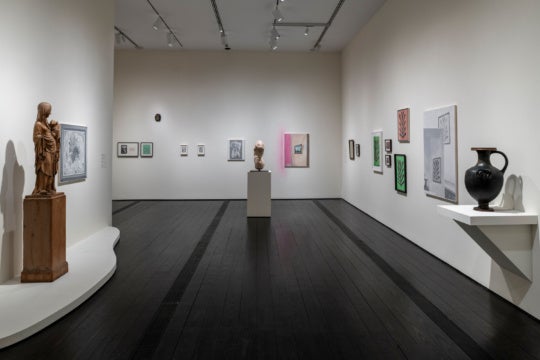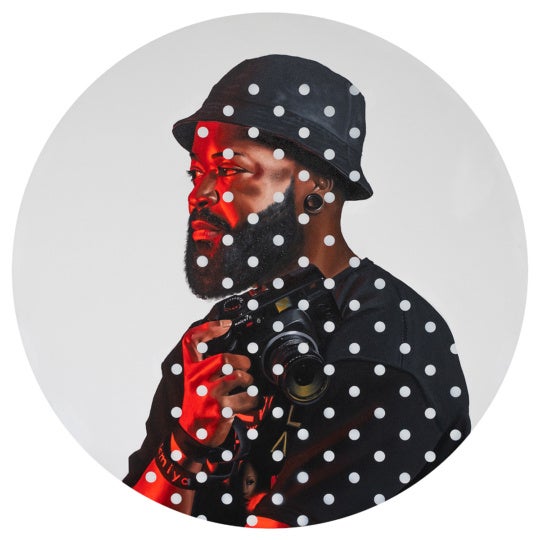
In 1930, twenty-one years after the publication of his Futurist Manifesto, Marinetti took on the dinner table with the “Manifesto for Futurist Cookery.” Dismissing pasta as a symbol of Italians’ bloated nostalgia for the past, Marinetti and his collaborator Fillía proposed eleven principles delineating the ideal Futurist meal, beginning with the statement “One perfect meal requires originality and harmony in the table setting.” In Ilana Harris-Babou’s video Cooking with the Erotic, an affectionate parody of cooking shows that borrows its dialogue from writers including Marinetti and Audre Lorde, this line is spoken by the artist’s mother. Heard in the context of the Zuckerman Museum of Art, where Cooking with the Erotic is on view through May 7 as part of the exhibition “Gut Feelings,” Marinetti’s calls for originality and harmony benefit an ambitious group show as much as they do a perfect meal. In mounting “Gut Feelings,” her first major curatorial effort at the Zuckerman, curator Sarah Higgins has achieved both of these things and more, locating food and eating at the center of a tangle of meditations on desire, power, gender, and commodification.
Without falling into easy gastronomic clichés or theory-driven didacticism, Higgins wrangles a broad array of artwork including works on paper, sculptural installations, and video with a curatorial touch that is as confident as it is light. The themes undergirding the exhibition unite the assembled works but don’t pigeonhole them, allowing for subtle relationships to emerge without feeling forced. This remarkable sense of conceptual buoyancy possessed by “Gut Feelings” reveals Higgins’s talent for coaxing multiple meanings out of artworks instead of instrumentalizing them as cudgels for a rigid curatorial agenda.

Building upon a series of recent works inspired by the history of navigation, Atlanta artist Michi Meko’s installation Studying the Silences: we used to eat this back home uses the dinner table as a site for uncovering cultural history and reclaiming inheritance. Placed against a black wall charted with cartographic lines and gold leaf details, Studying the Silences consists of a table set with black bowls, brass candlesticks, and bouquets of cotton bolls. Each leg of the table is different, perhaps evoking histories of resourcefulness or disparate but sturdy cultural foundations. Unlike Marinetti, whose “Manifesto for Futurist Cookery” aimed at leaving the past behind, Meko uses Studying the Silences to delve into the individual and collective memories contained within the traditions of Black American cuisine. Meko’s brand of Afrofuturism, divorced from the Italian Futurist preoccupation with linear progress, looks to the past as a way of navigating the present as well as the future.
Brooklyn-based ceramicist Jessica Stoller’s exquisite but sinister sculptures resemble objects depicted in 17th-century Dutch vanitas paintings, which often show skulls and rotting fruit as symbols of life’s brevity. The decadence conveyed by the glossy cakes, fruit, and flowers in Stoller’s Still Life, however, serves less as a momento mori and more as a pointed commentary on prescriptive notions of femininity and beauty. With cakes sprouting breasts and chains scattered among strings of pearls, Stoller’s ceramic table setting looks like it could have been lifted out of a surreal feminist fairy tale.

This wry critical tone is echoed in Desiring Image, a small work on paper in which artist Jeremy Jacob uses candy-colored acrylics to render Snow White taking a bite of the witch’s poisoned apple. Despite being recognizable as the Disney princess, the figure’s features are exaggerated and distorted, almost appearing to melt down the paper’s surface. Desiring Image transforms Snow White from a sanitized princess stereotype into a ravenous specter of desire and erotic appetite. In Dysmorphia (Fragment), another work on paper by Jacob, Snow White’s emaciated waist and swollen hands cartoonishly indicate hunger but also perhaps refer to eating disorders such as bulimia.

Martha Rosler’s 1975 video Semiotics of the Kitchen investigates another feminine archetype: the housewife. Like Cooking with the Erotic, Rosler’s Semiotics of the Kitchen riffs on the prosaic format of a daytime cooking show. Portraying a character she has described as an “anti-Julia Child,” Rosler dons an apron and demonstrates the use of common kitchen items including an egg beater, grater, and various utensils, each of which corresponds with a letter of the alphabet. As its title indicates, Semiotics of the Kitchen shows Rosler deconstructing the visual language of midcentury American housewives’ everyday routines. She does this by subverting the meaning of culinary tools through her performance, changing instruments of domestic service into metaphorical weapons. As the video progresses, Rosler’s mimed gestures take on a violent tone. When she demonstrates how to use a knife, her slashes through the air mimic stabbing more than cooking.

The violence contained within acts of cooking and feeding concerns many of the artists featured in “Gut Feelings,” as it did Irish-born British painter Francis Bacon. Asked by an interviewer about his childhood fascination with butcher shops, Bacon replied, “Well, of course, we are meat, we are potential carcasses. If I go into a butcher’s shop I always think it’s surprising that I wasn’t there instead of the animal.” In Indian artist Tejal Shah’s video Feed/Kill, one figure aggressively force feeds another, making it unclear if the person eating is being nourished or, in some perverse inversion, being prepared for the slaughter. Shah, like Bacon, seems to understand that the needs of humans’ fleshy bodies inevitably place us in cycles of competition and consumption. The sadomasochistic undertones of Feed/Kill, however, suggest an alternative model: a queer intimacy that acknowledges this potential violence while also allowing for pleasure, vulnerability, and trust.
Centering an exhibition on a cluster of topics like cooking and food risks overindulging contemporary art’s conceptual tendencies. Such a curatorial approach could cause the show to become too obviously about those concepts, or else rely so heavily on abstract theoretical arguments that the exhibition’s themes come off as rarified and academic. The harmony Higgins achieves in “Gut Feelings” evades both of these outcomes. The show isn’t simply about food, nor does it rely so heavily on feminist or queer theory that the viewer must perform awkward intellectual gymnastics connecting the artwork with the curator’s broader ideas. In a cultural moment that has been widely acknowledged, even outside the art world, as the heyday of curators, Higgins’s curatorial approach provides a needed example of restraint, balance, and faith in art’s generous open-endedness.
“Gut Feelings” is on view at the Zuckerman Museum of Art on the campus of Kennesaw State University through May 7.
Logan Lockner is Assistant Editor of BURNAWAY.




